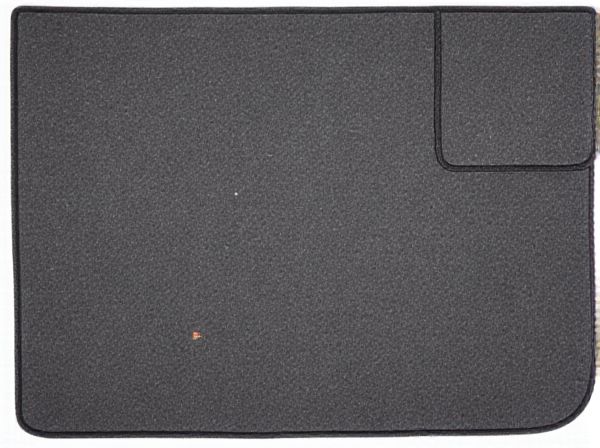
Photo illustration: Thermoformed Carpet vs Cut & Sewn Carpet
Thermoformed carpet offers a seamless and durable finish by molding fibers using heat, resulting in enhanced resilience and easy maintenance. Cut and sewn carpet involves stitching pre-cut pieces together, allowing for intricate designs and customization but may show seams over time. Your choice depends on whether you prioritize durability and smooth texture or design flexibility and detailed patterns.
Table of Comparison
| Feature | Thermoformed Carpet | Cut & Sewn Carpet |
|---|---|---|
| Manufacturing Process | Molded to shape using heat and pressure | Cut fabric sections sewn together |
| Fit Precision | High, exact mold fit | Good, depends on sewing accuracy |
| Durability | Resistant to wear and deformation | Less resistant, seams prone to wear |
| Cost | Higher due to molding process | Lower, simpler production |
| Installation | Faster, as one piece | Longer, multiple pieces to align |
| Customization | Limited to mold design | Flexible, various patterns possible |
| Common Use | High-end vehicles, OEM carpets | Aftermarket, budget models |
Understanding Thermoformed Carpet
Thermoformed carpet is created by heating and molding carpet fibers over a pre-shaped template, resulting in a seamless, durable, and precisely contoured floor covering ideal for automotive, marine, and custom interior applications. This process enhances water resistance, ease of cleaning, and fit in complex shapes compared to traditional cut and sewn carpets, which involve stitching separate fabric panels together. Understanding thermoformed carpet's unique production method highlights its advantages in performance, longevity, and tailored design solutions in specialized environments.
What Is Cut & Sewn Carpet?
Cut & Sewn Carpet refers to custom-made carpet sections that are individually cut and stitched together to fit specific areas or shapes within a vehicle or architectural space. This method allows for precise fitting and intricate designs by assembling multiple pieces of carpet, often using various materials and textures for enhanced aesthetics and durability. Compared to thermoformed carpet, Cut & Sewn Carpet offers greater flexibility in customization, especially for irregular or complex floor layouts.
Key Differences: Thermoformed vs Cut & Sewn Carpet
Thermoformed carpet is created by heating and molding synthetic fibers into specific shapes, offering durability and precise fitting ideal for automotive applications. Cut & sewn carpet involves cutting carpet material into panels and stitching them together, allowing flexible customization and easier repairs. Key differences include thermoformed carpet's seamless construction providing a sleek, wrinkle-free surface versus cut & sewn carpet's tailored sections that accommodate complex interior contours.
Manufacturing Process Comparison
Thermoformed carpet manufacturing involves heating and molding synthetic fibers into precise shapes using molds, allowing for seamless designs, enhanced durability, and consistent thickness. Cut and sewn carpet production requires cutting carpet sheets into specified patterns followed by stitching pieces together, offering more customization but resulting in visible seams and potentially less uniformity. The thermoforming process is highly automated, reducing labor intensity, whereas cut and sewn methods rely more on manual craftsmanship and intricate pattern alignment.
Durability and Longevity
Thermoformed carpet offers enhanced durability due to its seamless construction, reducing wear and tear compared to cut & sewn carpet, which can develop weak points at stitched seams. The thermoforming process creates a more resilient surface that resists deformation and fraying, extending the carpet's lifespan under heavy foot traffic conditions. Cut & sewn carpets, while customizable in shape and design, generally require more maintenance and may show signs of aging faster due to seam separation and edge wear.
Flexibility in Design and Customization
Thermoformed carpet offers enhanced flexibility in design by allowing seamless curves and complex shapes through heat molding, enabling precise fitment in custom vehicles or unique interiors. Cut & sewn carpet provides traditional customization with stitched seams, suitable for straightforward layouts but limited in accommodating intricate contours without visible joins. Designers seeking smooth, three-dimensional coverage typically prefer thermoformed carpet for its ability to maintain consistent texture and form, while cut & sewn remains economical and easier for standard rectangular or simple patterned areas.
Application Areas: Where Each Excels
Thermoformed carpet excels in automotive interiors and aerospace applications due to its ability to conform to complex shapes with minimal seams, offering enhanced durability and a custom fit. Cut and sewn carpet is preferred in residential and commercial flooring because it allows for intricate patterns and easy installation in irregular spaces. Each method optimizes performance based on the environment, with thermoformed carpet providing structural resilience and cut and sewn carpet delivering design flexibility.
Cost Analysis: Thermoformed vs Cut & Sewn
Thermoformed carpet offers a cost-effective solution due to lower labor and production expenses compared to cut & sewn carpet, which requires more intricate stitching and multiple material pieces. The streamlined manufacturing process of thermoformed carpets reduces material waste and assembly time, resulting in significant savings. While cut & sewn carpets provide customization and complex designs, their higher labor intensity and longer production cycles increase overall costs.
Environmental Impact and Sustainability
Thermoformed carpet employs heat and pressure to mold synthetic fibers, resulting in less fabric waste and lower energy consumption compared to cut & sewn carpet, which requires extensive cutting and stitching processes leading to higher material waste. The minimal waste production and recyclable nature of thermoformed carpets contribute significantly to environmental sustainability by reducing landfill contributions and resource depletion. In contrast, cut & sewn carpets often generate more offcuts and require additional adhesives, increasing their environmental footprint and complicating recycling efforts.
Choosing the Right Carpet for Your Needs
Thermoformed carpet offers a seamless, molded fit ideal for custom shapes and high-traffic areas, providing enhanced durability and easy maintenance. Cut & sewn carpet allows for greater design flexibility and intricate patterns, making it suitable for unique shapes and personalized aesthetics. Evaluating your space's specific requirements, such as foot traffic, design preferences, and installation complexity, ensures you select the most effective carpet solution.
 caratoz.com
caratoz.com